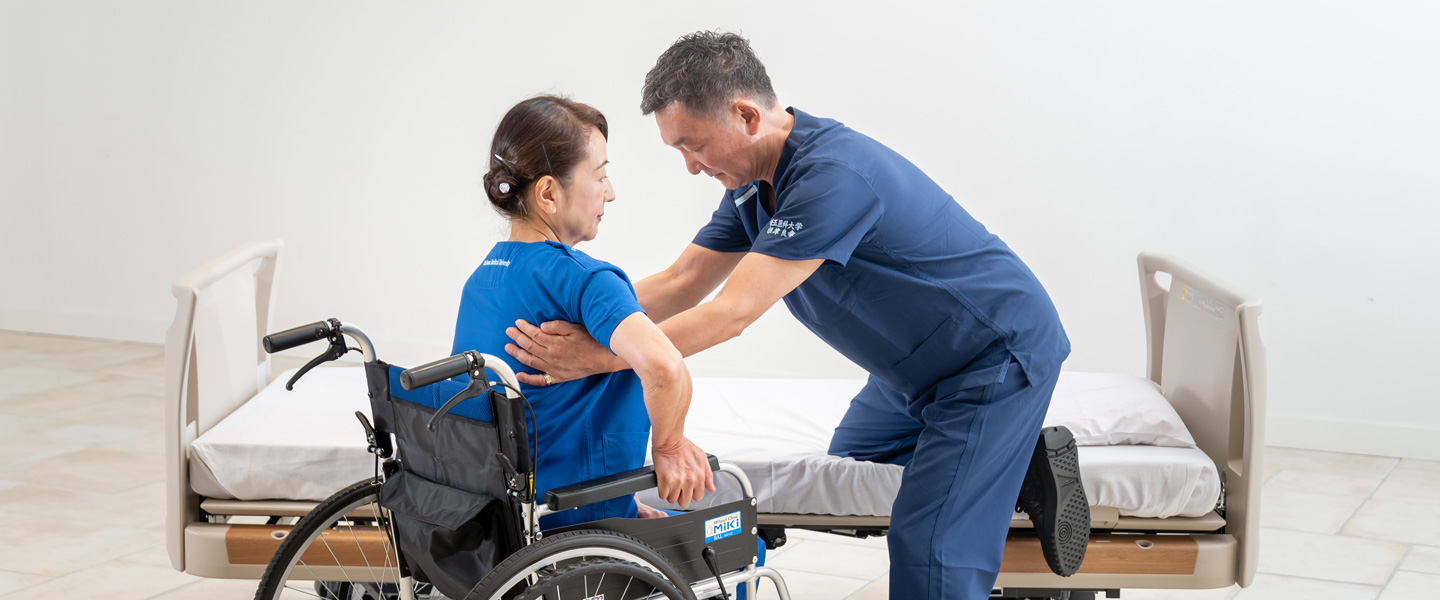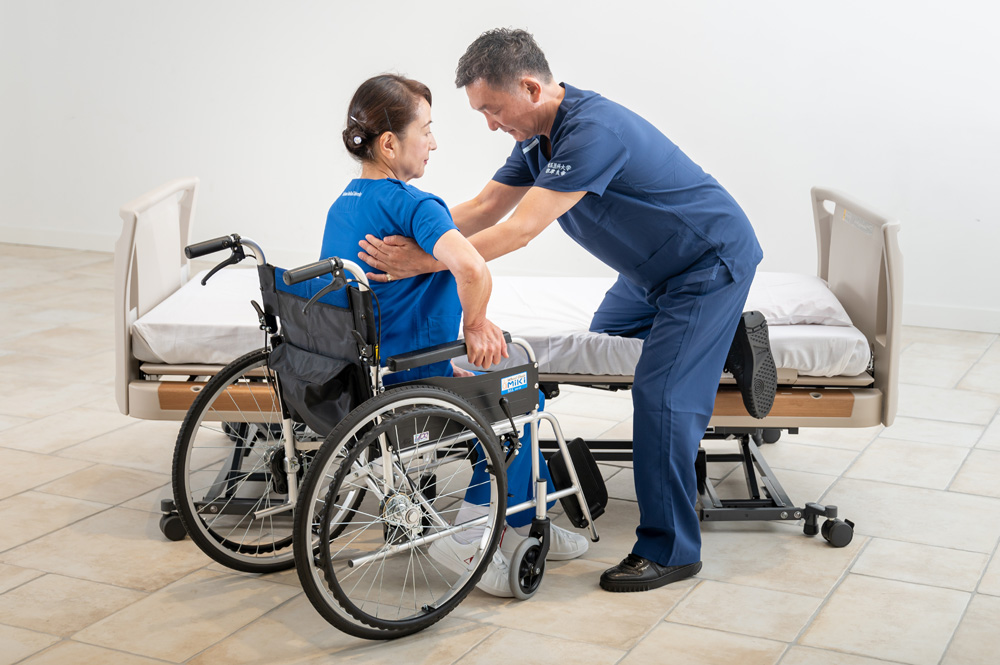

Curriculum
"Nezushiki Kaigogijutsu", a caregiving technique that do not burden the back at all
Why was this curriculum created?
- I myself had a stroke and became a care receiver myself.
- I have learned firsthand the feelings and movements of physically disabled people and the feelings of care recipients.
A burden-free caregiving technique that can be done with one arm.
Five points of burden-free caregiving
(1) Pull
(2) Push
(3) Turn
(4) Touch
(5) Change the fulcrum
Four points in conventional care (power care)
(1) Use the waist as a fulcrum
(2) Hold
(3) Grasping
(4) Lifting
Bed Section
- Touch, not grab. Only three fingers are used (Kakete)
- Changing positions that can be done with just one finger
- Changing positions with no back strain at all when there is a side rail
- How to raise an upper body of a care receiver with one arm
- How to raise an upper body of a high care receiver with one arm
- How to raise an upper body of a care receiver with no back strain at all when there is a side rail
- Holding the sitting position
- How to put a care receiver in bed without straining the back at all (holding the knee of a care receiver)
- How to put a care receiver in bed without straining the back at all (Kunoji-shiki)
- How to make a care receiver stand up with a hand guide that does not strain the back at all
- How to make a care receiver stand up without straining the back at all (Both arms hook-shiki)
- Techniques for raising the arms of a care receiver who has difficulty raising their arms
- How to make a care receiver with a high level of care stand up without straining the caregiver's back (holding in a caregiver’s arm)
- How to make a care receiver with a high level of care stand up without straining the caregiver's back (Touching the sitting bones of a care receiver)
- How to make a care receiver with a high level of care stand up without straining the caregiver's back (Touching a care receiver’s waist)
- How to make a care receiver with a high level of care stand up without straining the caregiver's back (Touching a care receiver’s shoulder blades)
- The direction in which a person falls
- Maintaining a standing position<Side type><Face-to-face type><Back type>
- Maintaining position in the bathroom<Back type>
- Emergency response method when a care receiver is about to fall suddenly (Kunoji-shiki)
- How to sit in a wheelchair without straining the back at all (Pushing a care receiver’s waist straight down with arms folded shape)
- How to transfer a care receiver from a bed to a wheelchair without straining the back at all
- How to make a care receiver stand up from a wheelchair without straining the back at all (Forward leaning posture / Cross-handed)
- How to make a care receiver re-sit when sitting shallowly on a wheelchair without straining the back at all (Cross-handed)
- How to make a care receiver stand up in a narrow bathroom without straining the back at all
- How to make a care receiver sit on the floor without straining the back at all
- How to make a care receiver sit on the floor by two caregivers without straining the back at all
Wheelchair Section
- Five points to check for a wheelchair (1) Head position, (2) Elbow position, (3) Waist position, (4) Ankle position, (5) Brake lever
- How to unfold a wheelchair
- How to fold a wheelchair
- How to raise the step board and feet with one finger
- How to place a care receiver's feet on the step board without straining the back
- How to step down a care receiver's feet from the step board without straining the back
- Easy way to push a wheelchair without straining the back
- How to stop a wheelchair comfortably without straining the back
- How to make a care receiver stand up from a wheelchair without straining the back (Both arms hook-shiki)
- How to make a care receiver stand up with a hand guide that does not strain the back
- How to make a care receiver with a high level of care stand up from a wheelchair without straining the back
- How to make a large care receiver stand up from a wheelchair without straining the back (Side up)
- How to make a care receiver stand up from a wheelchair without straining the back (on a rainy day)
- Maintaining a standing position<Side type><Face-to-face type><Back type>
- Maintaining position in the bathroom<Back type>
- Face-to-face position maintaining (Kunoji-shiki) Emergency response method when a care receiver is about to fall suddenly
- How to sit in a wheelchair without straining the back at all (Cross handed)
- How to make a care receiver re-sit when sitting shallowly on a wheelchair without straining the back at all (Cross-handed)
- How to transfer a care receiver from a wheelchair to a bed without straining the back at all
Fall Prevention Section
Why do so many fall accidents occur in facilities and hospitals?
・That's because there are two points missing.
You don't know which way people fall.
Unaware of the concept of maintaining position
- The direction in which a person falls
- Maintaining a standing position<Side type><Face-to-face type><Back type>
- Maintaining position in the bathroom<Back type>
- Face-to-face position maintaining (Kunoji-shiki)
- Holding the sitting position
- How to make a care receiver with a hand guide that does not strain the back at all
- How to stand up a care receiver without straining the back at all (Both arms hook-shiki)
- How to make a care receiver with a high level of care stand up without straining the caregiver's back (holding in a caregiver’s arm)
- How to make a care receiver with a high level of care stand up without straining the caregiver's back (Kunoji-shiki)
- How to sit in a wheelchair without straining the back at all (Pushing a care receiver’s waist straight down with arms folded shape)
- How to sit in a wheelchair without straining the back at all (Kunoji-shiki)
- How to make a care receiver sit on the floor without straining the back at all
Infection Prevention Section
A burden-free caregiving technique that can be done with one arm.
Five points of burden-free caregiving
The key to preventing infection is not to get too close together.
(1) Pull
(2) Push
(3) Turn
(4) Touch
(5) Change the fulcrum
Four points in conventional care (power care)
Getting too close to each other is not a good way to prevent infection.
(1) Use the waist as a fulcrum
(2) Hold
(3) Grasping
(4) Lifting
- Changing positions that can be done with just one finger in infection control
- Touch, not grab. Only three fingers are used (Kakete)
- How to raise an upper body of a care receiver with one arm in infection control
- How to put a care receiver in bed (Kunoji-shiki)
- How to make a care receiver stand up with a hand guide in infection control
- How to make a care receiver stand up in infection control (Both arms hook-shiki)
- Maintaining a standing position<1.Side type><2.Back type>
- Maintaining position in the bathroom<Back type>
- Face-to-face position maintaining (Kunoji-shiki) Emergency response method when a care receiver is about to fall suddenly
- How to make a care receiver sit in a wheelchair from the side in infection control (Pushing a care receiver’s waist straight down with arms folded shape)
- How to transfer a care receiver from a bed to a wheelchair in infection control
- How to make a care receiver stand up from a wheelchair in infection control (Forward leaning posture / Cross-handed)
- How to make a care receiver re-sit when sitting shallowly on a wheelchair in infection control (Cross-handed)
- How to make a care receiver stand up in a narrow bathroom
- Changing positions when there is a side rail in infection control
- How to raise an upper body of a care receiver when there is a side rail in infection control
